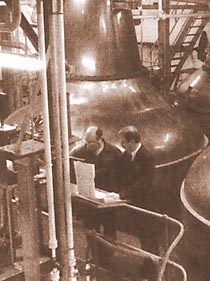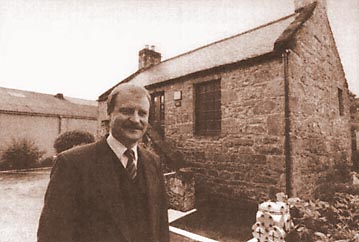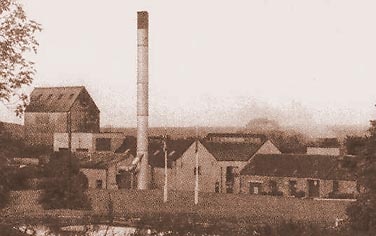
Glenburgie
Glencraig: The special one that got away

The Glenburgie-Glenlivet Distillery does not exactly flaunt
itself. It lies up a Morayshire back road between Forres and
Elgin without even a sign to declare its presence. It is a
distillery that metaphorically keeps its head down and gets on
with the job. There's a reason for this. Glenburgie's job is to produce
high-quality malt whisky for blending purposes - reliably and
efficiently - adding its special qualities to the Ballantine's
range and others such as the export blend Old Smuggler. Its
owners, Allied Distillers, do not bottle the Glenburgie as a
single, although it has been bottled by Gordon & MacPhail
and, of course, at cask-strength by the Society as No 71. But if almost all of the Glenburgie "disappears"
into the blends which make Scotch whisky an international
phenomenon, let us think now about a whisky from the same
distillery which has almost completely vanished. But not quite. This is called Glencraig. Between 1958 and 1981, the
Glenburgie-Glenlivet Distillery had two contrasting pairs of
pot-stills, one pair of the familiar swan-necked shape and the
other pair with shorter, cylindrical necks. These were known as
Lomond stills. Because of the quite different character of the whisky these
stills produced - richer and heavier, although from the same mash
- their product was given another name, Glencraig. Of course,
none has been produced since the Lomond stills were replaced by
swan-necks in 1981. So the Society's bottling of this whisky, as
No 104, was a taste of a disappearing heritage. In the Fifties, Glenburgie belonged to the Hiram Walker stable
of Scotch whisky distilleries and a spirit of experimentation was
abroad. The idea was to widen the character and style of the
company's malts with stills which altered the "reflux"
action by passing on heavier vapours to the condenser. The Lomond stills were designed to this end, made by
coppersmiths in Govan, Glasgow, and installed in pairs at
Glenburgie, Miltonduff and Inverleven. (Only one Lomond still - a
wash still in tandem with a traditional spirit still - is thought
to survive in operation, at Scapa Distillery in Orkney.) At Glenburgie-Glenlivet, the whisky from the Lomond stills was
named after the late Willie Craig, the company's production
director. His son Bill, now retired after becoming general
manager of Hiram Walker's Highland malt operations recalls this
episode - and also the fact that not all malt connoisseurs were
convinced that the Lomond stills significantly altered the
character of the dram. Feel free to argue about this, of course, if you ordered No
104. It's not likely to be around long, for the Lomond stills had
to be dismantled before they were removed from Glenburgie, a very
interesting distillery established in 1810 and now managed by
Brian Thomas. There is one unusual consequence from this time. Because the
Glencraig from the Lomond stills had to be kept apart from the
Glenburgie, there had to be two separate spirit safes and spirit
receiving vessels. These survive: so Glenburgie is probably the
only small malt distillery with just two pairs of stills which
enjoys this doubling-up. It has changed, too. The time when every distillery had its
resident excisemen is recalled by a door which once closed off
the cabinet where the excise officials kept their hydrometers and
other instruments for checking the government's share. On the
back of this door, generations of excisemen scrawled their names,
the way school pupils once did on their desk-lids. But in whisky-making today, Glenburgie-Glenlivet has another
distinction. It is one of the few distilleries where at the
mashing stage, four waters are applied instead of the usual
three. First, of course, the malted barley (grown in Moray or
Tayside, brought in at about 100 tonnes a week) is ground in the
Porteous mill. Brian Thomas tries to produce as fine a grist as
possible, which is always a balance between extraction of the
sugars and drainage requirements. He is working on proportions of
11 per cent flour, 22 per cent husks, and 67 per cent middles. Two final waters are sprayed into the mash tun, by which time
the temperature has reached boiling point. They extract the final
traces of sugars from the mash, and are retrieved to form the
first waters of the next cycle. Brian Thomas's ideal final product is a sweetish, fruity and
estery whisky. He believes strongly in the effect of yeasts upon
the final spirit, and unusually employs two distiller's and two
brewer's yeasts for each fermentation. We lifted the lid on one of the 13 washbacks and looked
inside. The fermentation had died back, and we saw a dense and
creamy head, the colour of an Italian footballer's suntan.
"That's what you want," said Brian. It smelt delicious.
God, I could have taken a dram of that and it hadn't even been
distilled. I had a good sniff, and I can smell it still. Anthony Troon Unless otherwise noted, all information in this site © The Scotch Malt Whisky Society, Edinburgh, Scotland, 1997. Among Glenburgie's other historical relics is the
tiny cottage-like building which first housed its original
offices and maturing cellar. Here is an indication of how the
whisky business has grown.
Among Glenburgie's other historical relics is the
tiny cottage-like building which first housed its original
offices and maturing cellar. Here is an indication of how the
whisky business has grown.  The first water is pumped into the mash
tun at 63.5 degrees C, and it takes two hours to complete the
filling. In due course, the worts progress to the fermenting
stage. When the second water is added at 95 degrees, from a
smaller tank, it is sprayed from above to get a good even mix
through the "bed" of grains. This raises the
temperature of the "bed" to 80 degrees. These worts
then go to fill the same washback.
The first water is pumped into the mash
tun at 63.5 degrees C, and it takes two hours to complete the
filling. In due course, the worts progress to the fermenting
stage. When the second water is added at 95 degrees, from a
smaller tank, it is sprayed from above to get a good even mix
through the "bed" of grains. This raises the
temperature of the "bed" to 80 degrees. These worts
then go to fill the same washback.